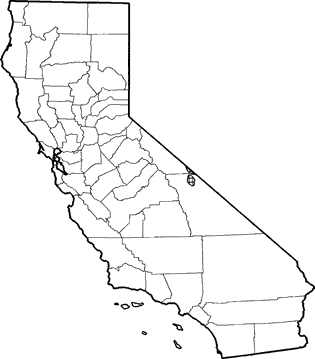
Pale Kangaroo Mouse
Distribution, Abundance, and Seasonality
In California, the pale kangaroo mouse occurs on the floors of the valleys Iying east of the White Mts., mainly Fish Lake and Deep Spring Valleys (Mono and Inyo cos.). Occurs in alkali desert scrub and low desert scrub habitats, and requires sand substrate. Elevation ranges 1530-1590 m (5100-5300 ft).

Range Map
Specific Habitat Requirements
Feeding: Seeds of forbs, shrubs, grasses, insects, and leafy vegetation transported to the burrow in cheek pouches.
Cover: A moderate canopy-coverage of saltbush/greasewood is preferred.
Reproduction: Burrows are excavated in fine sand, and range from 1-2.5 m (3-8 ft) long, usually 0.3-0.6 m (1-2 ft) below the surface (Hall 1946, Ingles 1965). Burrow entrances are plugged with sand during the day.
Water: Water is obtained metabolically, and from moisture in foods such as leafy vegetation and insects (O'Farrell and Blaustein 1974).
Pattern: Locally abundant in alkali desert scrub habitat with a substrate of fine sand. Hafner (1978) indicated that this species is restricted to sparsely vegetated sand dune habitats. SPECIES LIFE HISTORY Actvity Patterns: Nocturnal. Kangaroo mice are capable of entering torpor at very high, or very low, temperatures (Ingles 1965). Bartholomew and MacMillen (1961) induced torpor under laboratory temperatures of 5-26ÁC (41 -79ÁF), while Brown and Bartholomew (1969) noticed that low ambient temperature and reduced food induced torpor. Hall and Linsdale (1929) noted a major burst of activity just after sunset. Winter activity was reported by Hall (1946) and Brown and Bartholomew (1969).
Species Life History
Activity Patterns: None.
Seasonal Movements / Migration: Ghiselin (1970) reported maximum distances between capture locations of 237 m (790 ft) for males, and 132 m (440 ft) for females.
Home Range: Kangaroo mice are moderately aggressive, but true territoriality has not been documented.
Territory: The breeding season is from March to September, peaking in March to April. Litter size averages 4 young, ranging from 2-6 (Hall 1946).
Reproduction: Little information available. Habits apparently similar to M. megacephalus (M097). See that account.
Niche: Kangaroo mice are exceptionally good jumpers (for their size). Their hind feet have densely haired soles (to aid in movement over sand), and they use their tails as fat storage organs (Hall 1946). They are only marginally present in sagebrush in California, the predominant habitat in Nevada of both conspecific populations and the closely related M. megacephalus.
Sources & References
California Department of Fish and Game, 1999.
California's Wildlife, Sacramento, CA.
Written by: P. Brylski, reviewed by: H. Shellhammer, edited by: R. Duke
Bartholomew, G. A., and R. E. MacMillen. 1961. Oxygen consumption, estivation, and hibernation in the kangaroo mouse, Microdipodops pallidus. Physiol. Zool. 34:177-183. Brown, J. H., and G. A. Bartholomew. 1969. Periodicity and energetics of topor in the kangaroo mouse, Microdipodops pallidus. Ecology 50:705-709. Ghiselin, J. 1970. Edaphic control of habitat selection by kangaroo mice (Microdipodops) in three Nevada populations. Oecologia (Berlin) 4:248-261. Hafner, J. C. 1978. Evolutionary relationships of kangaroo mice, genus Microdipodops. J. Mammal. 59:354-365. Hall, E. R. 1946. Mammals of Nevada. Univ. California Press, Berkeley. 710pp. Hall, E. R., and J. M. Linsdale. 1929. Notes on the life history of the kangaroo mouse (Microdipodops). J. Mammal. 10:298-305. Ingles, L. G. 1965. Mammals of the Pacific states. Stanford Univ. Press, Stanford, CA. 506pp. O'Farrell, M. J., and A. R. Blaustein. 1974. Microdipodops pallidus. Mammal. Species No. 47. 2pp.
California Animal Facts | California's Wildlife